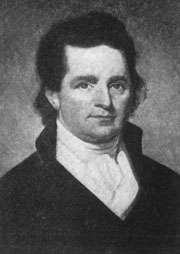Philip Barton Key
| Philip Key | |
|---|---|
 | |
| Member of the U.S. House of Representatives from Maryland's 3rd district | |
|
In office March 4, 1807 – March 3, 1813 | |
| Preceded by | Patrick Magruder |
| Succeeded by | Alexander Hanson |
| Chief Judge of the United States Circuit Court for the Fourth Circuit | |
|
In office February 20, 1801 – July 1, 1802 | |
| Preceded by | Position established |
| Succeeded by | Position abolished |
| Appointed by | John Adams |
| Personal details | |
| Born |
April 12, 1757 Charlestown, Maryland, British America |
| Died |
July 28, 1815 (aged 58) Washington, D.C., U.S. |
| Political party | Federalist |
| Spouse(s) | Ann Plater |
| Children | 1 |
| Education | Middle Temple |
Philip Barton Key Sr. (April 12, 1757 – July 28, 1815), was a Representative from the third district of Maryland, and later a United States federal judge. In contrast to most American politicians, of the Revolutionary era United States, Key enlisted, as a British Loyalist and fought against the American Revolution. After the war, Key was the only former, British American Loyalist to be regain prominence in United States politics.
Early life
Born in Charlestown. Cecil County, Maryland, Key pursued an academic course.
American Revolutionary War
During the American Revolutionary War, Philip Barton Key served in the Maryland Loyalists Battalion, as a captain.[1] Key fought under the British Army, from 1777-1781, until he was captured, by the Spanish Army, who were at war with the British, in Pensacola, Florida, with the rest of his battalion. Key was a prisoner, for a month, in Havana, Cuba, before being paroled and sent to New York City, until the end of the war.
English education and American politics

After the war, Key traveled to England to study law at the Middle Temple. In 1785 he returned to Maryland and read law to be admitted to the bar. He began practicing law in Leonardtown, Maryland in 1787, before moving to Annapolis in 1790, becoming a member of the Maryland House of Delegates from 1794 until 1799. He served as Mayor of Annapolis from 1797 to 1798. He returned briefly to private practice in Annapolis from 1799 to 1800.
On February 18, 1801, Key was nominated by President John Adams to a new seat on the United States circuit court for the Fourth Circuit, created by 2 Stat. 89. He was confirmed by the United States Senate on February 20, 1801, and received his commission the same day. He served as chief judge of that court from 1801-1802. Key's service was terminated on July 1, 1802, with the abolition of the court.
Key then returned to private practice, from 1802 to 1807. He was a Counsel to Justice Samuel Chase during Chase's Senate impeachment trial in 1805. During this time he built and lived in Woodley in Washington, DC.
In the fall of 1806 Key moved to Montgomery County, Maryland and became interested in agriculture. Between March 4, 1807 and March 3, 1813, he was elected as a Federalist to the Tenth, Eleventh and Twelfth U.S. Congresses. He also served as chairman for the Committee on District of Columbia during the Tenth Congress.
Death
On July 28, 1815, Key died in Washington County, D.C., and was interred on his Woodley estate. Later, he was re-interred at Oak Hill Cemetery in Washington, D.C.
See also
- Philip Key (U.S. politician), Key's cousin.
- Francis Scott Key, Key's nephew.
- Philip Barton Key II, Key's great-nephew.
- John Eager Howard, father-in-law of Key's daughter.
- George Plater, father-in-law.
References
- ↑ Conway Whittle Sams, Elihu Samuel Riley, The Bench and Bar of Maryland: A History 1634 to 1901 (1901), p. 292.
Sources
- United States Congress. "Philip Barton Key (id: K000159)". Biographical Directory of the United States Congress.
- Philip Barton Key at the Biographical Directory of Federal Judges, a public domain publication of the Federal Judicial Center.
- Purcell, L. Edward. Who Was Who in the American Revolution. New York: Facts on File, 1993. ISBN 0-8160-2107-4.
| Political offices | ||
|---|---|---|
| Preceded by John Bullen |
Mayor of Annapolis 1797–1798 |
Succeeded by Nicholas Carroll |
| Legal offices | ||
| New office | Chief Judge of the United States Circuit Court for the Fourth Circuit 1801–1802 |
Position abolished |
| U.S. House of Representatives | ||
| Preceded by Patrick Magruder |
Member of the U.S. House of Representatives from Maryland's 3rd congressional district 1807–1813 |
Succeeded by Alexander Hanson |